The BAT is the only Italian province with three capitals: Barletta, Andria, and Trani. These cities form a perfect triangle on the map, which includes and connects the municipalities of the sixth Apulian province, such as Bisceglie, Trinitapoli, Margherita di Savoia, San Ferdinando di Puglia, Minervino Murge, Spinazzola, and Canosa di Puglia.
This province is located in central-northern Apulia, between the Adriatic Sea and the Alta Murgia National Park, a protected natural area located in the hinterland, between the provinces of Bari and Barletta-Andria-Trani. The park is a karst plateau, characterized by rocks emerging among stretches of olive trees, ancient tracks, and historic farmhouses.
In the Alta Murgia National Park, you can spot wildlife such as falcons and foxes, follow hiking, horse riding, or mountain biking trails, and explore fascinating natural features such as hypogea, puli, sinkholes, and rock churches. The variety of flora and fauna offers an extraordinary experience of connecting with nature, among animal farms and landscapes rich in native plant species.
This area is also known as "Imperial Apulia", a name that pays homage to Frederick II of Swabia, who had a particular affection for this region and left an important historical legacy.
In Barletta, you can admire the famous Colossus of Eraclius and the grand Swabian Castle, which hosts exhibitions and cultural events throughout the year.
Andria will fascinate you with its most famous monument, Castel del Monte, a unique architectural masterpiece that blends cultural influences from Northern Europe, the Muslim world, and Classical antiquity.
Finally, Trani will surprise you with its picturesque harbor and the majestic Cathedral of San Nicola Pellegrino, which stands by the sea, offering a breathtaking view and a unique spiritual and cultural experience.
What to do nearby
Things to Do in Barletta Andria Trani
Barletta: History, Culture, and Gastronomy
Barletta, located on the picturesque Adriatic coast of Puglia, is a city rich in history, art, traditions, and natural beauty.
Thanks to its strategic position and cultural heritage, it is an ideal destination for those who want to immerse themselves in the history of southern Italy, exploring monuments, archaeological sites, and savoring its renowned local cuisine.
Barletta is well connected to Bari and other cities in Puglia through an efficient transportation system.
Two railway lines serve the city: the national network of Ferrovie dello Stato, which connects Barletta to major Italian cities, and the Ferrovie Nord Barese commuter service, which passes through cities like Andria and Ruvo di Puglia, making it easy to travel for both visitors and workers.
Bari Palese Airport, located about 50 km away, is the nearest airport, well-connected to Barletta via trains and buses, making the city easily accessible even for those arriving by air.
Main attractions of Barletta
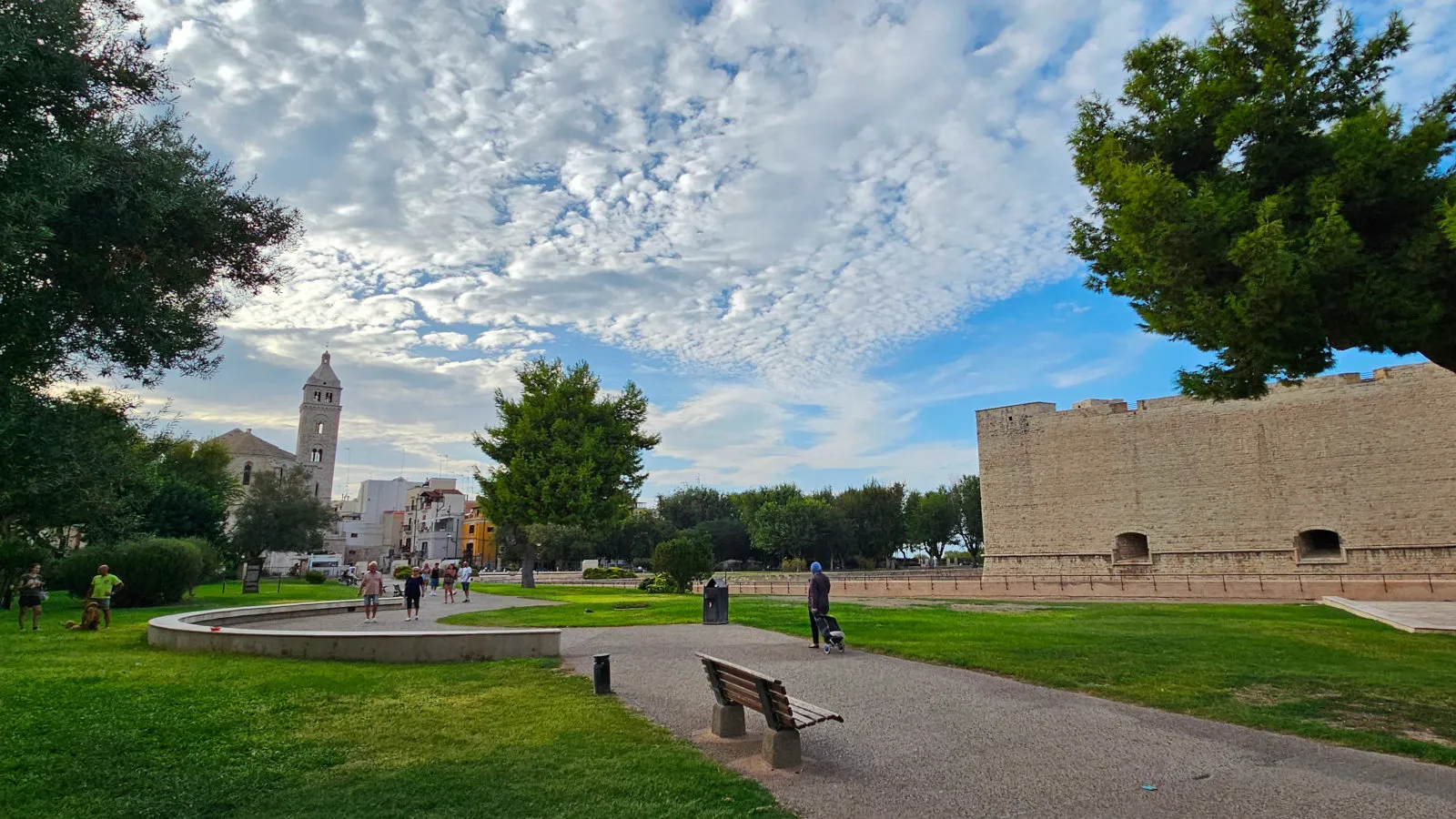
Barletta is a city deeply rooted in history and rich in monuments of great value.
One of the most iconic is the Colossus of Eraclius, a majestic bronze statue over five meters high, representing one of the greatest examples of late Roman art. This imposing figure, known as the "Giant," is one of the most beloved symbols of the city and is located near the Basilica of the Holy Sepulchre, one of the most important churches in Barletta.
The basilica houses precious sacred relics and has a strong connection to the pilgrimages of crusaders heading to the Holy Land during the Middle Ages.
Dominating the city is the Norman-Swabian Castle, a massive medieval fortress reflecting Barletta's military importance over the centuries.
The castle, accessible through a charming park, has been expanded and modified over the centuries, with its current appearance mainly attributed to the 16th-century reconstruction. Inside, it houses the Civic Museum, which hosts temporary and permanent exhibitions of local art and history.
In the heart of the historic center stands the Cathedral of Santa Maria Maggiore, a magnificent example of Romanesque and Gothic architecture.
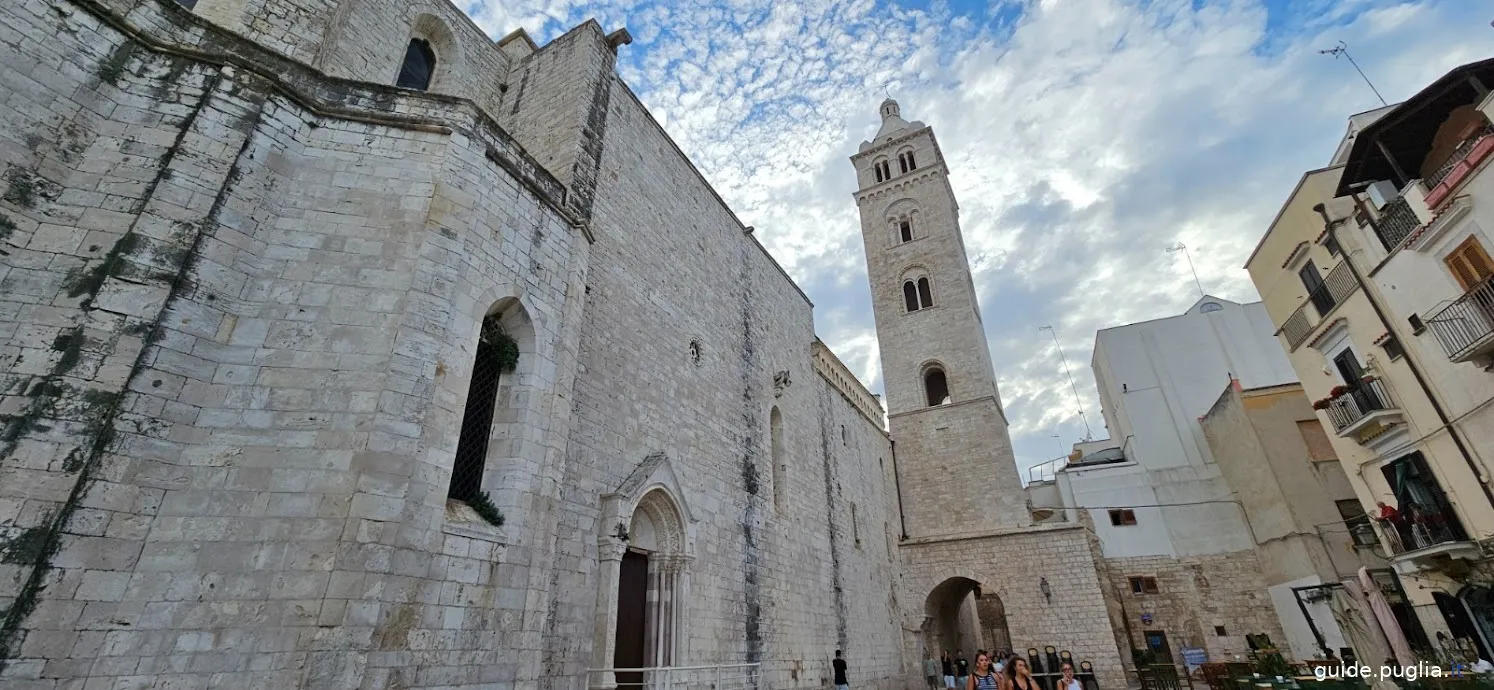
This sacred building played a key role in the religious and political history of the city, including the coronation of Charles of Anjou. The cathedral is also famous for its paleochristian crypt, a place of great charm for visitors.
Barletta is famous for being the stage of the celebrated Disfida di Barletta, which took place in 1503.
This historical event, a chivalric duel between 13 Italian knights and 13 French knights, is a source of pride for the city and is commemorated at the Cantina della Disfida, where the Italian knights, led by Ettore Fieramosca, planned the challenge.
The cantina, open to the public, is decorated in period style and tells the story of this important event through informational panels.
A short distance from the city is the Archaeological Park of Canne della Battaglia, one of the most significant historical sites in the region.
It was here, in 216 BC, that the famous Battle of Cannae took place, where Hannibal defeated the Roman army in one of the most celebrated battles in military history. The site offers a fascinating journey into the past, among archaeological remains and breathtaking natural landscapes, with panoramic views stretching across the Puglian countryside.
Barletta is also a city of art, thanks to the De Nittis Art Gallery, located in the magnificent Palazzo della Marra. This gallery is dedicated to Giuseppe De Nittis, an impressionist painter from Barletta, whose works are exhibited alongside temporary exhibitions of contemporary artists.
De Nittis' paintings, which capture Parisian atmospheres and scenes of modern life, represent one of the highest moments of 19th-century Italian painting.
Barletta is also known for its splendid beaches. The Ponente Beach, with its fine, light sand, is perfect for families and offers numerous well-equipped beach resorts, while the Levante Beach, quieter, is ideal for those seeking relaxation or wanting to practice water sports. The wilder stretches, such as the coastline of the Fiumara, offer a more natural experience.
The History of Barletta
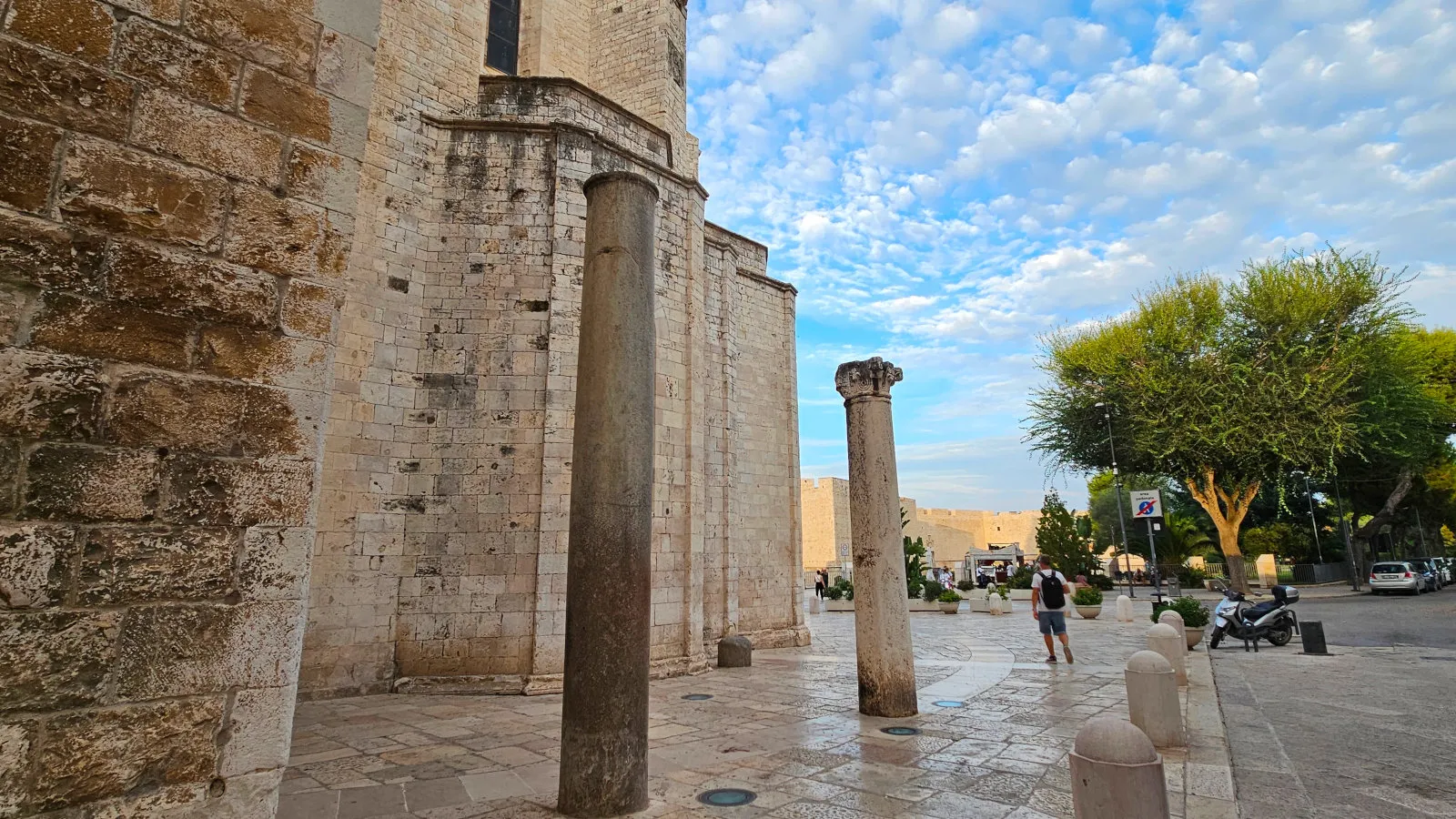
Barletta has ancient origins, dating back to the Dauni, a pre-Roman Italic population. During the Roman period, the city, then known as Bardulos, became an important commercial hub thanks to its strategic position on the Adriatic, connecting Italy with the East and the Balkans.
In the Middle Ages, under the Normans (11th century), Barletta gained prominence, especially as a port for crusaders heading to the Holy Land. During this period, the Norman-Swabian Castle was built, which became one of the city's symbols.
Under the rule of Frederick II of Swabia (13th century), the city further strengthened, becoming a strategic fortification in the Kingdom of Sicily.
One of the most celebrated episodes in the history of Barletta is the Disfida di Barletta in 1503, a chivalric duel between 13 Italian and 13 French knights, which ended with the victory of the Italians, led by Ettore Fieramosca. This event is still proudly celebrated by the city today.
From the 16th century, under Spanish rule, Barletta entered a period of economic decline due to wars, plagues, and heavy taxation. However, in the 18th century, under the Bourbons, it experienced some economic and urban recovery.
During the Risorgimento, Barletta was actively involved in the uprisings for the unification of Italy.
In the 20th century, the city suffered significant damage during World War II, but recovered in the post-war period, becoming an important agricultural and commercial center.
Today, Barletta is a vibrant city, known for its rich cultural heritage, the Colossus of Barletta, the Swabian Castle, and the re-enactment of the Disfida di Barletta, attractions that continue to draw visitors.
Barletta also has a strong spiritual connection with Capurso due to the common devotion to the Madonna del Pozzo, one of the most venerated Marian figures in the Puglia region.
The cult of the Madonna del Pozzo originated in Capurso in 1705, when it is said that the priest Domenico Tanzella was miraculously healed after drinking the water from a well near a chapel dedicated to the Madonna. From that moment, the image of the Virgin, found in the same well, began to be venerated, and the cult quickly spread to many places in Puglia, including Barletta.
The religious connection between Barletta and Capurso: The Madonna del Pozzo
Barletta has embraced this devotion with great fervor. Although the main sanctuary of the Madonna del Pozzo is in Capurso, the Marian tradition has deeply taken root in Barletta, where the Madonna is invoked as a protector and source of spiritual grace.
Numerous pilgrims from Barletta, in the past and even today, travel to Capurso to pay homage to the Madonna, especially during the main celebrations.
In Barletta, the Madonna del Pozzo is commemorated through various religious and cultural celebrations, which testify to the community's devotion to the Virgin.
Among the most significant events are:
Feast of September 8: On the occasion of the Nativity of the Blessed Virgin Mary, a festival is held in honor of the Madonna del Pozzo. On this day, processions are organized through the city's streets, with the image of the Madonna carried in a procession by the faithful. The procession is accompanied by moments of prayer and songs dedicated to the Virgin.
Special religious services: Throughout the year, but especially in August and September, solemn masses are held in honor of the Madonna del Pozzo. These services are followed by the faithful, who gather to ask for protection and grace from the Virgin.
Pilgrimages to Capurso: Some groups of faithful from Barletta organize pilgrimages to the Sanctuary of the Madonna del Pozzo in Capurso, especially during the main feast of the sanctuary, which is celebrated on the last Sunday of August. The pilgrimages represent a sign of devotion and continuity of faith between the two cities.
What to do nearby
Gastronomic Culture
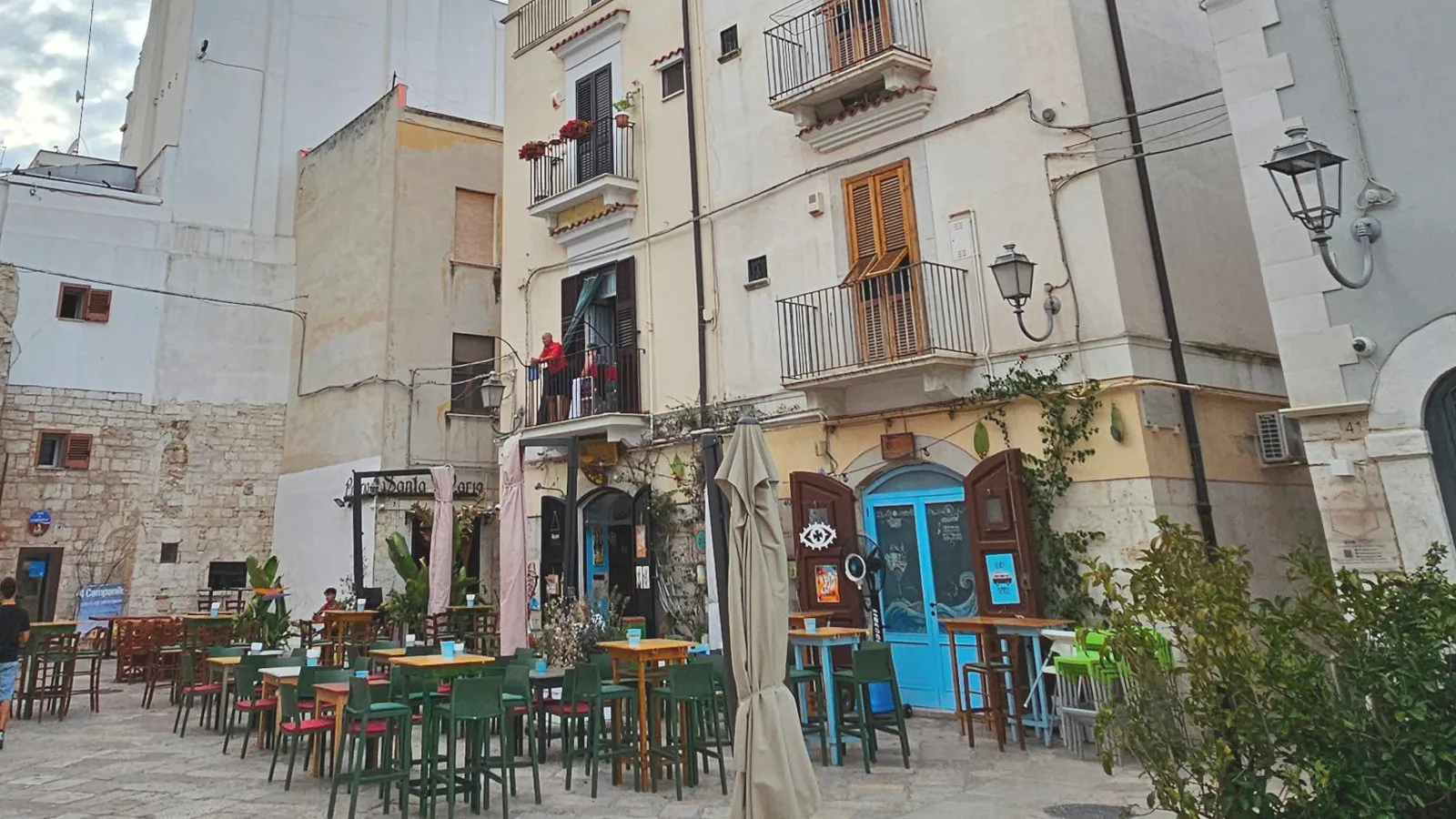
The cuisine of Barletta reflects Puglian tradition, famous for its simple yet intense flavors. Among the typical dishes are orecchiette with turnip tops, cavatelli with seafood, and a variety of dishes based on fresh fish.
Barletta is also renowned for its production of lampascioni, pickled or in oil, a local delicacy, and for traditional sweets such as pastarelle, locally known as "Pscènn d'ì Mònch," passed down from generation to generation. All this is accompanied by excellent wines, such as the Rosso Barletta DOC, a full-bodied wine with an intense flavor, representing one of the finest products of the local wine industry.
Andria: History, Culture, and Gastronomy
Andria, a fascinating city in Puglia, is a place that surprises with its rich history, culture, and authentic flavors. Nestled between the Adriatic Sea and the hills of the Murgia, this city offers a unique combination of natural landscapes, extraordinary architecture, and centuries-old traditions.
One of its most famous symbols is the majestic Castel del Monte, a fortress built in the 13th century by Frederick II of Swabia. What makes this castle truly unique is its perfect octagonal geometry, which has captivated scholars and visitors for centuries.
Castel del Monte, with its eight identical towers, is not just a defensive structure: it is a "stone enigma." It is said that Emperor Frederick II designed it with symbolic meaning linked to astronomy and mathematics, perfectly integrating it into the surrounding landscape. The view from the castle is spectacular: on one side, you can overlook the Murgia valley, while on the other, you can admire the deep blue Adriatic Sea.
It's no surprise that this monument was declared a UNESCO World Heritage Site in 1996.
The historic center of Andria is equally captivating, a maze of narrow streets and squares that tell centuries of history. The Cathedral of Santa Maria Assunta, with its majestic Romanesque-Gothic architecture, houses one of the most precious relics of Christianity: the Sacred Thorn from the crown of Christ. Every year, the faithful gather to venerate this extraordinary gift received from Beatrice of Anjou. Not far from there is the Crypt of Saint Richard, dedicated to the city's patron saint.
Another must-see is the Basilica of Santa Maria dei Miracoli, a place that is not only for worship but also a true journey through art and history.
Built in the 16th century, the basilica is spread across three levels, each representing a different era: from the 9th-century rock-cut church, to the splendid upper church of the 17th century, designed by the architect Cosimo Fanzago. The intermediate level, entirely frescoed, offers a breathtaking visual display with scenes depicting the Passion of Christ.
Andria's iconic bell towers are another highlight, rising above the cityscape. Among them, the bell tower of the Cathedral, the one at San Francesco, and the bell tower of the Church of San Domenico stand out, offering picturesque views from every angle. Each is a testament to different eras, intertwining history and faith.
However, Andria is not just about history and art; it is also a gastronomic paradise. The Burrata di Andria IGP, a fresh and creamy cheese, is one of the most appreciated and renowned products of the city. This delicacy can be enjoyed on its own, with a drizzle of extra virgin olive oil, or accompanied by warm, fragrant focaccia.
The burratas, traditionally wrapped in green asphodel leaves, maintain their freshness and are a symbol of a dairy tradition passed down through generations. Other typical dishes worth trying include cutturidd, a savory stew of lamb or goat, and the famous orecchiette with turnip tops, a classic of Puglian cuisine that wins over with its simplicity and bold flavors.
All of this is paired with high-quality olive oils and glasses of local DOC wines, such as Castel del Monte Nero di Troia, perfect for enhancing the flavors of the local cuisine.
For those with a sweet tooth, Andria offers an unforgettable experience with its Museum of Confetti. Located near the Cathedral, the museum tells the story of the city's confetti production, an ancient tradition, through a collection of historical tools and, of course, delicious tastings. Here, you can discover confetti filled with Puglian almonds, hazelnuts, and chocolate, often enriched with a touch of local liquor.
But Andria is not only about gastronomy—it is also a hub of culture. The city hosts the prestigious Festival Castel dei Mondi, an international event dedicated to contemporary theater that transforms the city into a lively open-air stage. During the festival, artists from all over the world perform in unique shows, enriching the cultural offering of the city and attracting theater and art enthusiasts.
Andria is also famous for its religious celebrations, particularly the Feast of Saint Richard, held annually on April 23rd. On this occasion, the city comes alive with processions, fireworks, and moments of prayer, blending the sacred and the profane in a deeply engaging experience.
Throughout its history, Andria has played a significant role, especially during the Norman-Swabian era. It is said that it was here that Frederick II married his second wife, Yolanda of Brienne, Queen of Jerusalem, strengthening the city's connection to the Swabian dynasty.
In conclusion, Andria is a city that perfectly blends its historical soul with a vibrant cultural and gastronomic life. Every corner of the city tells a story, every dish reflects a tradition, and every visit leaves an unforgettable memory.
Trani, the "Pearl of the Adriatic": Between History, Culture, and Gastronomy
Trani, known as the "Pearl of the Adriatic", is a coastal city that captivates with its timeless beauty. Located along the Apulian coast, Trani is like a gem set between the sea and history, where traces of the past coexist with a vibrant daily life.
One of the most characteristic places is undoubtedly the picturesque port, the beating heart of the city.
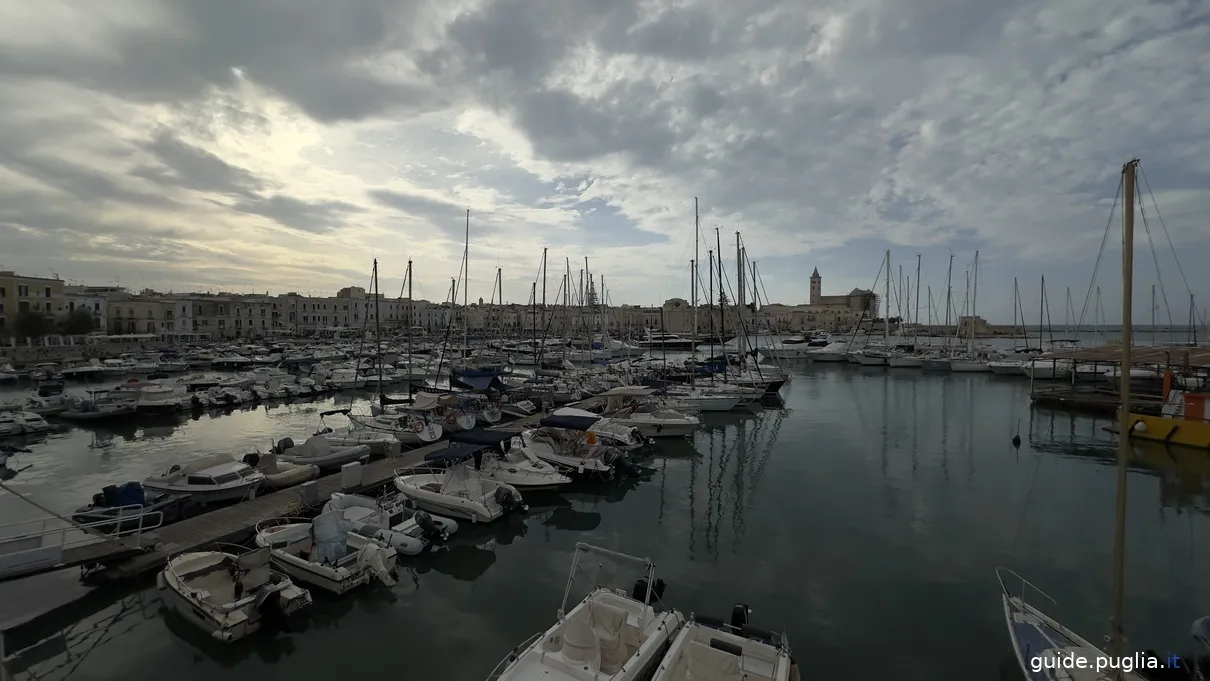
Here, time seems to slow down: during the day, fishermen unload their fresh catch, while in the evening, the port comes alive with bars and restaurants offering seafood specialties. The port of Trani has played a crucial role in the city's history, being one of the most important ports in the Kingdom of Naples and a crossroads for trade between East and West.
Dominating the coastal landscape is the majestic Cathedral of San Nicola Pellegrino, one of the most spectacular examples of Apulian Romanesque architecture. Built with local white stone, known as "Pietra di Trani", the cathedral stands tall over the sea, creating a stunning contrast between the whiteness of its facade and the blue of the waters.
This stone, renowned for its durability and beauty, has contributed to the construction of many historic buildings across Italy. Inside the cathedral, in addition to the main nave, there is an older church, Santa Maria della Scala, and a crypt that houses the relics of San Nicola Pellegrino, a young Greek pilgrim who died in Trani in 1094 and became the city's patron saint.
Not far from the cathedral, you will find another historical symbol of the city: the Castello Svevo, built by Emperor Frederick II of Swabia in the 13th century. This imposing fortress overlooks the sea and, over the centuries, has played a strategic role in defending the Apulian coast.
Today, the castle is open to the public and hosts temporary exhibitions, cultural events, and guided tours that allow visitors to explore its ancient halls and discover the history of Trani.
But Trani is not just a Christian city: during the Middle Ages, it was also home to a flourishing Jewish community, one of the most important in southern Italy. Today, as a testament to that past, you can visit the Scola Nova Synagogue, one of the oldest synagogues in Europe, built in the 13th century.
This sacred place, which was turned into a church during persecutions, returned to being a synagogue in the 1990s, and today it represents an important testimony to the Jewish heritage in Puglia.
Walking through the streets of Trani is like stepping back in time. The historic center is a maze of medieval alleys, where architectural gems like the Palazzo Caccetta, an elegant Renaissance building built in the 15th century, and the Church of Ognissanti, erected by the Knights Templar in the 12th century, stand out. Every corner of the historic center reveals a part of the city's millennial history, where Byzantine, Norman, and Swabian influences blend.
And of course, you can't talk about Trani without mentioning its rich culinary tradition. The city's cuisine is closely tied to the sea, with dishes made from the freshest seafood available at the many restaurants lining the port.
Local specialties include stuffed mussels, sea urchins, and grilled fish, often accompanied by a glass of Moscato di Trani, one of the oldest and most prized wines of the region. Moscato di Trani, made from sun-dried grapes, is a sweet and liqueur-like wine with a golden color, featuring intense aromas of ripe fruit and honey, perfect for accompanying typical Apulian desserts like cartellate or almond biscuits.
Trani is also a city of culture and traditions. Among the most important events is the Festa di San Nicola Pellegrino, held every year in July with religious processions, fireworks displays, and celebrations involving the entire city. Trani also hosts various cultural festivals, such as the Trani Film Festival and the Festival of Jewish Culture, celebrating the city's rich multicultural heritage.
Trani is a city that knows how to surprise and enchant. With its extraordinary historical heritage, its picturesque corners, and its refined cuisine, it offers a unique experience that blends tradition and modernity.
